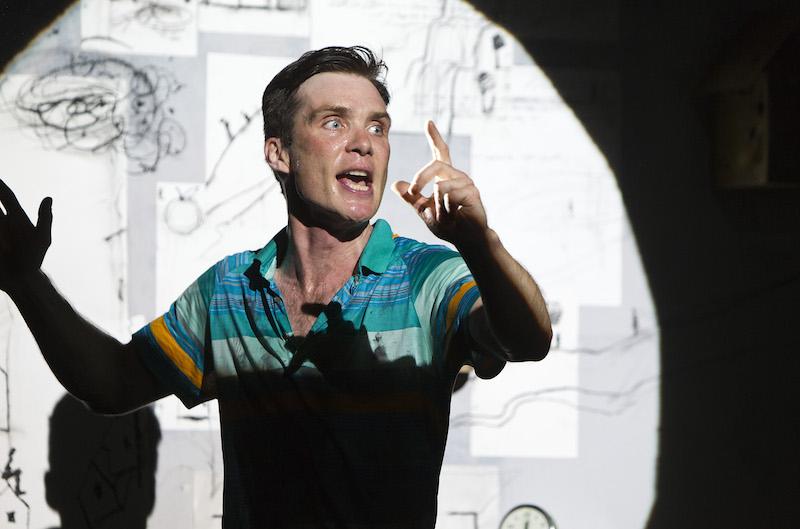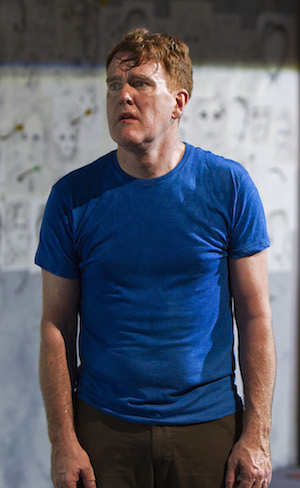Ballyturk, National Theatre | reviews, news & interviews
Ballyturk, National Theatre
Ballyturk, National Theatre
Enda Walsh's unsettling comedy triumphs at the Lyttelton

In his masterly essay in the programme for Enda Walsh's latest play, Colm Tóibín warns against attempting to pin his work to a particular philosophical position, but simply to read into it a metaphor for humanity's efforts to cope with life while knowing that there is no escape from death. And certainly an attempt at blow-by-blow analysis – even understanding – would be a waste of time. Ballyturk is a thing in and of itself.
This is what we see. Two friends share a shabby room which they never leave. The setting, we are told, is "No time. No place", but it is also, of course, specifically Irish. Tóibín's description of Walsh's characters as being left "in a Trojan horse with the battles for Troy all over" is apt, although this place has the trappings of a particular, run-down twentieth-century dwelling: cuckoo clock, microwave, fridge, drop-down bed and dingy shower. It also has a wall covered in drawings and a curtained screen with the word "Ballyturk" in neon revealed at precisely the same moment each day. There are faces drawn on the screen and, as names are called to fit them, 1 or 2 aims darts at them.  Cillian Murphy plays 1 and Mikel Murfi 2. Murphy has a small frame and an angelic face which can sometimes take on a sinister aspect: in BBC 2's Peaky Blinders his knife-blade cheek bones rival the lethal razor blade in his cap and his piercing blue eyes might dazzle an opponent to death. Here he is fearful, given to fits and manic. Equally frenetic is Mikel Murfi (pictured right), chunkier, red-haired and able to inhabit dozens of characters in an instant by swiftly adapting his body in a sequence of mimes. Both actors fling themselves about the stage under Walsh's own demanding direction. The physical comedy, involving changes of clothes, balloons, loud music, dancing, an alarm clock and various furnishings, is wild, fast, often hilarious and sometimes melancholy, recalling Keaton's sad-eyed, zany purposefulness.
Cillian Murphy plays 1 and Mikel Murfi 2. Murphy has a small frame and an angelic face which can sometimes take on a sinister aspect: in BBC 2's Peaky Blinders his knife-blade cheek bones rival the lethal razor blade in his cap and his piercing blue eyes might dazzle an opponent to death. Here he is fearful, given to fits and manic. Equally frenetic is Mikel Murfi (pictured right), chunkier, red-haired and able to inhabit dozens of characters in an instant by swiftly adapting his body in a sequence of mimes. Both actors fling themselves about the stage under Walsh's own demanding direction. The physical comedy, involving changes of clothes, balloons, loud music, dancing, an alarm clock and various furnishings, is wild, fast, often hilarious and sometimes melancholy, recalling Keaton's sad-eyed, zany purposefulness.
Whether Ballyturk is a real place to 1 and 2, whether the characters impersonated by the pair are figments of their imagination, whether the whole idea of a community is notional – all these are open to question. All we know for sure is that these two are together and that they have a ritual, interdependent existence and occasionally hear other voices beyond their walls. Day follows day according to a pattern, although there is also a sense that they don't quite know what might happen next. Above all, they are friends. Then: Enter 3.
Stephen Rea plays 3, a cooler, cigarette-smoking talker. He might be a version of the Grim Reaper; some have described him as the Godot who did show up. Whoever he is, he disrupts the status quo as, in drama, the unexpected visitor always will.
Like Misterman, Walsh's previous play starring Cillian Murphy at the National, this is a Landmark Production which began life at the Galway Festival. Once again Jamie Vartan and Adam Silverman are responsible for spot-on design and lighting respectively. Helen Atkinson as sound designer and composer Teho Teardo provide an atmospheric, sometimes disturbing soundscape. All the actors are superb.
Despite his venture into musicals with Once, Enda Walsh retains his ability to unsettle, to place side by side daft slapstick, playful theatricality and sublime poetry. As Stephen Rea has said of Ballyturk: "It isn't about something; it is something."
rating
Explore topics
Share this article
The future of Arts Journalism
You can stop theartsdesk.com closing!
We urgently need financing to survive. Our fundraising drive has thus far raised £49,000 but we need to reach £100,000 or we will be forced to close. Please contribute here: https://gofund.me/c3f6033d
And if you can forward this information to anyone who might assist, we’d be grateful.

Subscribe to theartsdesk.com
Thank you for continuing to read our work on theartsdesk.com. For unlimited access to every article in its entirety, including our archive of more than 15,000 pieces, we're asking for £5 per month or £40 per year. We feel it's a very good deal, and hope you do too.
To take a subscription now simply click here.
And if you're looking for that extra gift for a friend or family member, why not treat them to a theartsdesk.com gift subscription?
more Theatre
 Dracula, Lyric Hammersmith review - hit-and-miss recasting of the familiar story as feminist diatribe
Morgan Lloyd Malcolm's version puts Mina Harkness centre-stage
Dracula, Lyric Hammersmith review - hit-and-miss recasting of the familiar story as feminist diatribe
Morgan Lloyd Malcolm's version puts Mina Harkness centre-stage
 Reunion, Kiln Theatre review - a stormy night in every sense
Beautifully acted, but desperately grim drama
Reunion, Kiln Theatre review - a stormy night in every sense
Beautifully acted, but desperately grim drama
 The Code, Southwark Playhouse Elephant review - superbly cast, resonant play about the price of fame in Hollywood
Tracie Bennett is outstanding as a ribald, riotous Tallulah Bankhead
The Code, Southwark Playhouse Elephant review - superbly cast, resonant play about the price of fame in Hollywood
Tracie Bennett is outstanding as a ribald, riotous Tallulah Bankhead
 The Lady from the Sea, Bridge Theatre review - flashes of brilliance
Simon Stone refashions Ibsen in his own high-octane image
The Lady from the Sea, Bridge Theatre review - flashes of brilliance
Simon Stone refashions Ibsen in his own high-octane image
 Romans: A Novel, Almeida Theatre review - a uniquely extraordinary work
Alice Birch’s wildly epic family drama is both mind-blowing and exasperating
Romans: A Novel, Almeida Theatre review - a uniquely extraordinary work
Alice Birch’s wildly epic family drama is both mind-blowing and exasperating
 The Producers, Garrick Theatre review - Ve haf vays of making you laugh
You probably know what's coming, but it's such great fun!
The Producers, Garrick Theatre review - Ve haf vays of making you laugh
You probably know what's coming, but it's such great fun!
 Not Your Superwoman, Bush Theatre review - powerful tribute to the plight and perseverance of Black women
Golda Rosheuvel and Letitia Wright excel in a super new play
Not Your Superwoman, Bush Theatre review - powerful tribute to the plight and perseverance of Black women
Golda Rosheuvel and Letitia Wright excel in a super new play
 Cow | Deer, Royal Court review - paradox-rich account of non-human life
Experimental work about nature led by Katie Mitchell is both extraordinary and banal
Cow | Deer, Royal Court review - paradox-rich account of non-human life
Experimental work about nature led by Katie Mitchell is both extraordinary and banal
 Deaf Republic, Royal Court review - beautiful images, shame about the words
Staging of Ukrainian-American Ilya Kaminsky’s anti-war poems is too meta-theatrical
Deaf Republic, Royal Court review - beautiful images, shame about the words
Staging of Ukrainian-American Ilya Kaminsky’s anti-war poems is too meta-theatrical
 Laura Benanti: Nobody Cares, Underbelly Boulevard Soho review - Tony winner makes charming, cheeky London debut
Broadway's acclaimed Cinderella, Louise, and Amalia reaches Soho for a welcome one-night stand
Laura Benanti: Nobody Cares, Underbelly Boulevard Soho review - Tony winner makes charming, cheeky London debut
Broadway's acclaimed Cinderella, Louise, and Amalia reaches Soho for a welcome one-night stand
 The Pitchfork Disney, King's Head Theatre review - blazing with dark energy
Thrilling revival of Philip Ridley’s cult classic confirms its legendary status
The Pitchfork Disney, King's Head Theatre review - blazing with dark energy
Thrilling revival of Philip Ridley’s cult classic confirms its legendary status
 Born with Teeth, Wyndham's Theatre review - electric sparring match between Shakespeare and Marlowe
Rival Elizabethan playwrights in an up-to-the-minute encounter
Born with Teeth, Wyndham's Theatre review - electric sparring match between Shakespeare and Marlowe
Rival Elizabethan playwrights in an up-to-the-minute encounter

Add comment